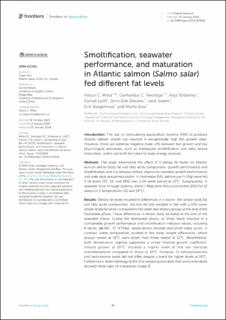| dc.description.abstract | The use of recirculating aquaculture systems (RAS) to produce Atlantic salmon smolts has resulted in exceptionally high fish growth rates. However, there are potential negative trade-offs between fast growth and key physiological processes, such as inadequate smoltification and early sexual maturation, which can both be linked to body energy reserves. This study determined the effect of i) dietary fat levels on Atlantic salmon whole-body fat and fatty acids composition, growth performance and smoltification and ii) a previous dietary regime on seawater growth performance and male early sexual maturation. In freshwater RAS, salmon parr (~19g) were fed 3 fat levels (20, 24, and 28%) over a 14-week period at 12℃. Subsequently, in seawater flow-through systems, smolt (~96g) were fed a control diet (26%) for 12 weeks at 2 temperatures (12 and 16℃). Dietary fat levels resulted in differences in k-factor, fish whole-body fat and fatty acids composition; the low fat diet resulted in fish with a 23% lower whole-body fat when compared to the other two dietary groups at the end of the freshwater phase. These differences in whole-body fat faded at the end of the seawater phase. During the freshwater phase, all three feeds resulted in a comparable growth performance and smoltification indicator values, including k-factor, gill Na+, K+-ATPase, blood serum chloride and smolt index score. In contrast, water temperature resulted in fish body weight differences, where groups reared at 16℃ were larger than those reared at 12℃. Nevertheless, both temperature regimes supported a similar thermal growth coefficient. Smolts grown at 16℃ showed a higher level of the sex steroids androstenedione compared to those at 12℃. However, 11-ketotestosterone and testosterone levels did not differ despite a trend for higher levels at 16℃. Furthermore, testis histology at the final sampling indicated that some individuals showed initial signs of maturation (stage 3). In conclusion, varying dietary fat levels (20 - 28%) during the freshwater phase did not influence smoltification or male early sexual maturation during the subsequent grow-out phase. However, a temperature increase from 12 to 16°C resulted in larger fish and appeared to stimulate early male maturation in some fish individuals. | |
